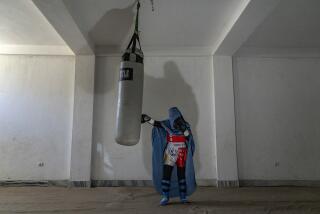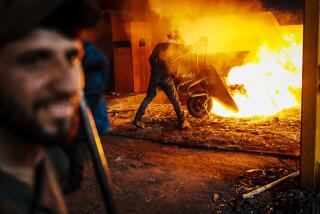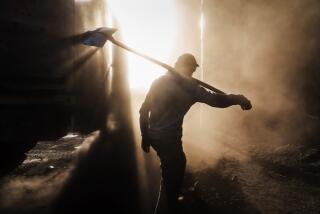A Lavish Palace for Omar’s Asceticism
- Share via
KANDAHAR, Afghanistan — Call it Chez Omar, or the palace under the mountain. The sprawling pink monstrosity that was home to Taliban leader Mullah Mohammed Omar has become Kandahar’s main tourist attraction.
On Wednesday, hundreds of men in baggy trousers who had followed their tribal leaders to the compound for consultations with Afghanistan’s new interim leader, Hamid Karzai, clambered up and down piles of broken bricks, leaped into bomb craters and scrambled onto roofs.
They gaped at the size and modernity of Omar’s compound, and at the destruction wrought upon it by the U.S. military.
Despite his reputation as an austere and humble man, Omar and his family lived in a style that would have been the envy of 99.9% of the Afghan people.
Sprawled out on a flat desert plain below a mountain shaped like the Rock of Gibraltar, and hidden from view by a high brick wall, the trapezoid-shaped compound was not lavish in the sense of palaces of other leaders around the world. There were no signs of expensive marble or gilded wallpaper.
But there was space aplenty--about 10 acres. It had clean white walls, a decorative staircase, gardens for vegetables and herbs, pink-tiled bathrooms with imported faucets and, out front, an elaborate bronze fountain depicting a forest of intertwined trees and branches with a brook running through it.
The walls of the largest garden were lined with a series of bucolic murals, with scenes including a canal, a mountain, a river and a medieval fortress.
Compared to the decrepitude and abject poverty of the rest of the country, the compound completed about three years ago--reportedly with money from Osama bin Laden and his Arab sympathizers--would have been magnificent. And that irked some of the visitors Wednesday.
“This was the blood money of the Taliban. Mullah Omar collected this money after he became the leader,” said Abdul Shakkar, a Karzai supporter who was going through the ruins. “Before that, he had nothing. In the beginning, he declared to the whole nation of Afghanistan that ‘I have come as a mullah, and I believe in the Holy Koran.’ After that he changed. He became a lover of money, and he sold the blood of the moujahedeen who fought for 22 years.”
But others saw it differently.
“This bombing is a very big mistake,” said Obaidullah Watandust, a tribal elder from Helmand province, staring at the particularly heavy damage meted out to the section of the compound that was said to house Omar’s mostly Arab bodyguards.
“We built something here, and they bombed it, and innocent people were martyred here. This is a defeat of Islam. We spent a lot of [money] that the American people are destroying.”
Despite the ambivalence of some of Karzai’s new followers, at least a few Americans are at the compound.
On Wednesday, they included a group of U.S. Special Forces, in desert khaki uniforms and floppy brimmed hats, who had set up communications gear on the roof of one building. As Karzai conferred with elders inside, they were outside coming and going in pickup trucks, armed with shiny black M-16 rifles.
Aside from saying, “No photographs” and “We don’t want pictures,” they stolidly brushed off greetings and ignored attempts at conversation.
A clue to what the Special Forces may be up to came when one soldier collected a group of loitering tribal warriors and brought them to a back corner of the compound. There he asked them--through an interpreter--to pass word to their commanders that he was willing to train the men to fight, according to an Afghan journalist who listened to the conversation.
Only about half of Omar’s compound was destroyed, a possible indication that U.S. bombers knew which parts of the complex were most likely to house Omar, his top deputies and military leaders and fighters from Bin Laden’s Al Qaeda terrorist network.
In one section, a red vest for carrying an infant lay atop a pile of bricks. Nearby, a metal cradle sat gathering dust.
In a room identified to reporters as the bedroom of Omar’s mother, there were two chandeliers, a ceiling fan, a built-in bookcase and cabinets, with walls painted saffron yellow.
The room was relatively intact, except for its cracked ceiling, broken window and the dust and debris on the floor.
A Pakistani newspaper reported early in the war that one of Omar’s sons and an uncle were killed by bombs dropped on the compound and that Omar himself survived by taking shelter in a ditch. The report is widely believed here in Kandahar.
In any case, it is not known how or when Omar fled the complex. The tribal leaders now in charge of Kandahar say they have no idea where he is.
“Mullah Omar has not been seen by anyone,” declared Mullah Naquibullah, Kandahar’s acting military commander, during an appearance at the compound Wednesday to talk to Karzai. “When we came in the morning, he had already left.”
Standing on the roof of the compound, looking at the panoramic view of mountains and desert, one possible escape route is apparent. A lonely road leads away from the front gate, up to the mountain that looms just to the west.
Locals report that there are some trenches and military positions up in the heights, and past the mountain there is mostly emptiness.
One small package of medicine was left behind on the terrace built for the wives of the Taliban leader and his companions.
Although there is no way to know whether it was used by members of Omar’s family, it seemed appropriate.
It was for a drug called Modrin, and on the package it promised the user: “Relief of depression, anxiety, tension.”
*
Times staff writer Kim Murphy in Kandahar contributed to this report.
More to Read
Sign up for The Wild
We’ll help you find the best places to hike, bike and run, as well as the perfect silent spots for meditation and yoga.
You may occasionally receive promotional content from the Los Angeles Times.






